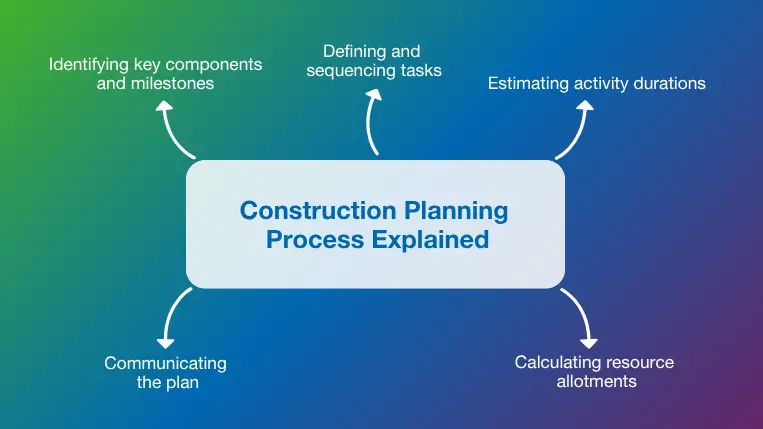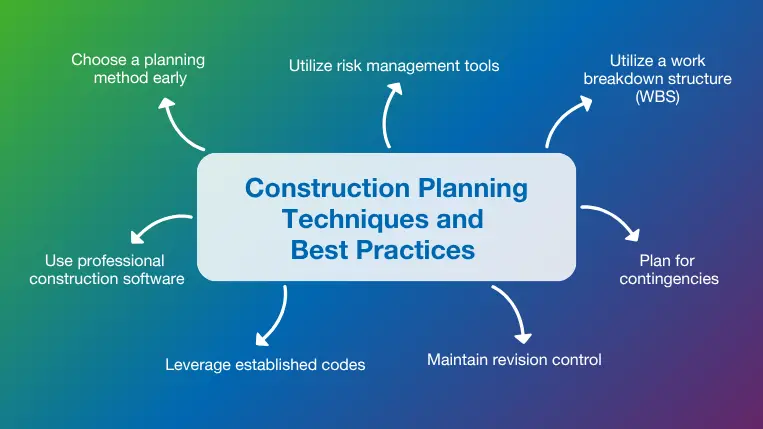11 mins read
The Basics of Effective Construction Planning: Tips and Best Practices for Successful Projects

Effective planning is crucial in the construction industry, as even the slightest miscalculation can result in costly delays or overruns in the future. Patience and attention to detail are valuable traits, but it is also essential to adhere to established rules and conventions that facilitate a smoother planning process.
In this blog post, we review the definition and importance of construction planning, along with the steps and responsibilities that feed into a successful plan. We also provide a list of useful tips and best practices to help streamline planning methods.
What is Construction Planning?
Construction planning is the process of identifying all steps that go into a project, then defining and arranging the tasks and activities within an organized timeline structure. These planning activities help to determine what labor, materials, and equipment are needed.
This methodical process yields a construction project management plan, which is a set of documents and specifications prepared to describe all activities, resources, and schedule constraints. Interactions between the various workflows are also discussed in the plan, since they help to establish the timeline, scope of work (SOW), and basic framework that directly impact all stakeholders. Completion of this roadmap is one of the first major milestones for any construction project.
Types of Plans in Construction
Like most complex activities, construction project planning relies on a series of smaller activities that establish the overall framework. Each activity requires different perspectives, expertise, and information. The most common types of plans in construction include:
- Strategic: High-level planning activities define project goals and objectives to determine the necessary resources and timeline.
- Operational: A tactical planning phase is necessary to turn strategic goals into well-defined tasks and performance metrics at the operational level.
- Business: The business perspective is applied to project costs, schedules, and expectations to define financial success and identify business risks.
- Resource: Human, material, and equipment resources must be identified, forecasted, and allocated properly to ensure on-time completion and project success.
Each facet of the planning process overlaps with the others, so it is important to consider the project goals, risks, and constraints from all perspectives to establish an overarching project plan.
Who is Responsible for Construction Planning?
Various disciplines and stakeholders participate in providing the details for construction planning and scheduling, but construction project managers or dedicated construction planners are typically responsible for ensuring this task is completed. Clients, architects, and design engineers also play important roles, as they share their data, guidance, and experience with managers and planners.
General contractors, consultants, and suppliers must also be involved in the planning process, since detailed information on subcontractors, material costs, construction site constraints, and equipment requirements can only be gathered from the stakeholders closest to each task or workflow.
Benefits of Effective Construction Project Planning
Decisions made during the planning phase can have a ripple effect that impacts cost and timeline performance throughout a project. The time spent creating a detailed and accurate project plan will pay long-term dividends. The benefits of effective planning in construction include:
- Projected schedules and budgets that align with actual timelines and expenses
- Identification of potential risks and roadblocks early on
- Increased efficiency and team coordination on the jobsite
- Improved decision-making and collaboration between stakeholders
An effective plan acts as a guide to consistently point teams in the right direction, while allowing project leaders to chart progress against baseline expectations. The plan should also be a living document that is updated as needed to accommodate design or scope changes.
Construction Planning Process Explained

There are many well-known and accepted construction planning techniques, including Critical Path Method (CPM), Program Evaluation and Review Technique (PERT), and Line of Balance (LOB) techniques, which leverage the similarities between common work elements. No matter which methods are used, the planning process should always include a few basic elements:
Identifying key components and milestones
The first step in creating an accurate plan is developing a basic outline that can eventually accommodate every project element in fine detail. This involves establishing boundaries and translating high-level objectives into specific milestones and budget constraints.
Defining and sequencing tasks
Perhaps the most tedious aspect of the planning process is defining each task accurately based on the time, materials, and labor required. As these individual pieces take shape, software tools are useful for identifying relationships between tasks and sequencing them in the most logical and efficient order.
Estimating activity durations
Historical records can be a helpful resource when determining expected task durations; however, there is no substitute for direct feedback from contractors or subcontractors when finalizing time allocations.
Calculating resource allotments
Once the appropriate tasks, workers, and materials are established, a resource loading formula is used to determine how much of a given resource’s time is dedicated to each task. This ensures teams have available bandwidth for each scheduled activity.
Communicating the plan
Even when stakeholders provide their input throughout the planning process, it is essential to share the plan and gather feedback before it is completed and approved. This communication helps to minimize errors, misunderstandings, and unscheduled plan revisions.
Construction Planning Techniques and Best Practices

Strategic planning in construction is a process that has evolved over centuries, but many teams and projects still fail to create accurate and valuable plans. Adhering to a few basic guidelines and practices helps to unlock the value of comprehensive planning.
1. Choose a planning method early
With several standard techniques and many software platforms available, choosing the right combination of tools and methods early helps to expedite the planning process and plot a successful course. For example, PERT techniques can be helpful for complex projects with built-in uncertainty, while LOB methods can be ideal for more repetitive projects. When software tools are used, they should complement the established basic planning techniques and strategies.
2. Utilize risk management tools
Construction risk management practices and tools ensure that all potential project risks, hazards, and unknowns are identified early on, allowing them to be eliminated or mitigated through prioritized corrective actions. Risk management is also an essential input for the construction planning phase, since a defined risk mitigation plan is needed to create accurate timelines and budgets.
3. Utilize a work breakdown structure (WBS)
A work breakdown structure (WBS) is a valuable construction planning tool, as it enables the systematic breakdown of complex tasks into more manageable components. This structured approach helps to avoid scope creep while making it easier to understand the project costs and allocate resources appropriately. The WBS also provides a convenient way to track the progress of each activity and identify potential bottlenecks.
4. Plan for contingencies
A typical construction contingency budget is set between 5-10% of the overall budget, depending on the level of project risk and number of unknowns. A robust risk management process and historical reviews allow project teams to establish realistic contingencies early and apply them to the financial, operational, and resource elements of the plan.
5. Maintain revision control
No matter how much effort goes into planning, builds rarely, if ever, go as expected. Adjusting and editing the plan quickly can prevent these situations from becoming a hindrance. This means following established revision control and approval processes to maintain compliance and ensure updates are available before outdated information can lead to errors or unnecessary rework.
6. Leverage established codes
Numerical coding systems, such as CSI MasterFormat, make it easier for project managers, estimators, and contractors to organize information, classify tasks, and communicate using a common language. Numerical codes can also simplify construction planning management by providing a standard format for project information that begins during the planning phase and remains consistent over the life of the project.
7. Use professional construction software
Software tools are essential for project planning in construction, as they enable teams to access the most current information and update plans in real-time. RIB Candy software for estimating, planning, and project control seamlessly links time and money and provides a robust critical path network for the built environment. Ready access to data and advanced planning features from a single user interface also helps eliminate departmental silos, ensuring projects are successful from the early stages through to the end.
Conclusion
The time and effort dedicated to planning is never wasted, especially for complex construction tasks with a wide array of variables and stakeholders. Many of the tips and best practices we have outlined were applicable decades ago. Still, the latest construction software tools provide an opportunity to streamline planning for the next generation of projects.
Candy Construction Software simplifies the planning process with a versatile quantity takeoff (QTO) module, along with features and functionalities like resource-based estimating, subcontractor management, and real-time cost comparisons that improve visibility, accuracy, and timeliness.
RIB Candy is trusted by thousands of companies worldwide to enhance their design, planning, and project execution results. Get your free demo today and discover what professional planning software can do for your organization!

Most Recent
11 mins read
11 mins read
10 mins read
10 mins read
Blog Categories

Ebook











